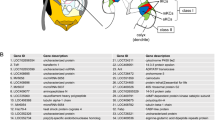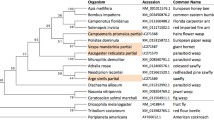Abstract
Mushroom bodies (MBs) are insect brain centers involved in sensory integration and memory formation. In social Hymenoptera, MBs are large and comprise larger number of Kenyon cells and have repeatedly been implied to underlie the social behaviors. In the present study, to facilitate our understanding of the neural basis of social behaviors, two complementary DNAs (cDNAs) encoding presumed ecdysone receptor isoforms (CjEcR-A and CjEcR-α) were identified in the developing brains of the carpenter ant Camponotus japonicus. Sequence comparison indicated that these CjEcR proteins had common DNA- and hormone-binding domains linked to different N-terminal regions. The alignment of the distinct regions with other insects EcRs indicated that CjEcR-A is the ant homologue of EcR-A, and CjEcR-α has a novel type of A/B region. Immunohistochemical analyses of the MBs of C. japonicus with the common region antibody demonstrated that these CjEcRs appear in all neuroblasts, neurons, and glia cells during neurogenesis, whereas expression is confined to the neurons, disappearing in the glia cells in newly emerged workers. Less expression was observed in the forager MBs. These findings suggest that CjEcRs are involved in maturation and development of ant MBs.




Similar content being viewed by others
References
Antoniewski C, Laval M, Hahan A, Lepesant JA (1994) The ecdysone response enhancer of the Fbp1 gene of Drosophila melanogaster is a direct target for the EcR/USP nuclear receptor. Mol Cell Biol 14:4465–4474
Antoniewski C, O’Grady MS, Edmondson RG, Lassieur SM, Benes H (1995) Characterization of an EcR/USP heterodimer target site that mediates ecdysone responsiveness of the Drosophila Lsp-2 gene. Mol Gen Genet 249:545–556
Antoniewski C, Mugat B, Delbac F, Lepesant JA (1996) Direct repeats bind the EcR/USP receptor and mediate ecdysteroid responses in Drosophila melanogaster. Mol Cell Biol 16:2977–2986
Billas IML, Iwema T, Garnier JM, Mitschler A, Rochel N, Moras D (2003) Structural adaptability in the ligand-binding pocket of the ecdysone hormone receptor. Nature 426:91–96
Cherbas L, Lee K, Cherbas P (1991) Identification of ecdysone response elements by analysis of the Drosohila Eip28/29 gene. Genes Dev 5:120–131
Cherbas L, Hu X, Zhimulev I, Belyaeva E, Cherbas P (2003) EcR isoforms in Drosophila: testing tissue-specific requirements by targeted blockade and rescue. Development 130:271–284
Danforth BN, Ji S (1998) Elongation factor-1. a. occurs as two copies in bees: Implications for phylogenetic analysis of EF-1. a. sequences in insects. Mol Biol Evol 15(3):225–235
D’Avino PP, Crispi S, Cherbas L, Cherbas P, Furia M (1995) The moulting hormone ecdysone is able to recognize target elements composed of direct repeats. Mol Cell Ecdocrinol 113:1–9
Ehmer B, Gronenberg W (2004) Mushroom body volumes and visual interneurons in ants: comparison between sexes and castes. J Comp Neurol 469:198–213
Farris SM, Robinson GE, Davis RL, Fahrbach SE (1999) Larval and pupal development of the mushroom bodies in the honey bee, Apis mellifera. J Comp Neurol 414:97–113
Green S, Chambon P (1988) Nuclear receptors enhance our understanding of transcription regulation. Trends Genet 4:309–314
Gronenberg W, Heeren S, Hölldobler B (1996) Age-dependent and task-related morphological changes in the brain and the mushroom bodies of the ant, Camponotus floridanus. J Exp Biol 199:2011–2019
Hara K (2002) A sensitive and reliable assay for queen discrimination ability in laboratory-reared workers of the ant Camponotus japonicus. Zool Sci 19:1019–1025
Hara K (2003) Queen discrimination ability of ant workers (Camponotus japonicus) coincides with brain maturation. Brain Behav Evol 62:56–64
Hölldobler B, Wilson EO (1990) The ants. The Belknap Press of Harvard University Press, Cambridge, pp 732
Horner MA, Chen T, Thummel CS (1995) Ecdysteroid regulation and DNA binding properties of Drosophila nucler hormone receptor superfamily members. Dev Biol 168:490–502
Hu X, Cherbas L, Cherbas P (2003) Transcription activation by the ecdysone receptor (EcR/USP): identification of activation functions. Mol Endocrinol 17:716–731
Ishii Y, Kubota K, Hara K (2005) Postembryonic development of the mushroom bodies in the ant, Camponotus japonicus. Zool Sci 22:743–753
Ito K, Hotta Y (1992) Proliferation pattern of postembryonic neuroblasts in the brain of Drosophila melanogaster. Dev Biol 149:134–148
Kapitskaya M, Wang S, Cress ED, Dhadialla TS, Raikhel AS (1996) The mosquito ultraspiracle homologue, a partner of ecdysteroid receptor heterodimer: cloning and characterization of isoforms expressed during vitellogenesis. Mol Cell Endocrinol 121:119–132
Koell MR, Talbot WS, Segraves WA, Bender MT, Cherbas P, Hosness DS (1991) The Drosophila EcR gene encodes an ecdysone receptor, a new member of the steroid receptor superfamily. Cell 67:59–77
Kumar MB, Fujimoto T, Potter DW, Deng Q, Palli SR (2002) A single point mutation in ecdysone receptor leads to increased ligand specificity: Implications for gene switch applications. PNAS 99:14710–14715
Lee T, Marticke S, Sung C, Robinow S, Luo L (2000) Cell-autonomus requirement of the USP/EcR-B ecdysone receptor for mushroom body neuronal remodeling in Drosophila. Neuron 28:807–818
Lehmann M, Korge G (1995) Ecdysone regulation of the Drosophila Sgs-4 gene is mediated by the synergistic action of ecdysone receptor and SEBP 3. EMBO J 14:716–726
Levine RB, Fahrback SE, Weeks JC (1991) Steroid hormones and the reorganization of the nervous system during metamorphosis. Sem Neurosci 3:437–447
Malun D (1998) Early development of mushroom bodies in the brain of the honeybee Apis mellifera as revealed by BrdU incorporation and ablation experiments. Learn Mem 5:90–101
Malun D, Moseleit AD, Grünewald B (2003) 20-Hydroxyecdysone inhibits the mitotic activity of neuronal precursors in the developing mushroom bodies of the honeybee, Apis mellifera. J Neurobiol 57:1–14
Mangelsdorf DJ, Evans RM (1995) The RXR heterodimers and orphan receptors. Cell 83:841–850
Mangelsdorf DJ, Borgmeryer U, Heyman RA, Zhou JY, Ong ES, Oro AE, Kakizuka A, Evans RM (1992) Characterization of three RXR genes that mediate the action 9-cis retinoic acid. Genes Dev 6:329–344
Menzel R (2001) Searching for the memory trace in a mini-brain, the honeybee. Learn Mem 8:53–62
Mouillet JF, Henrich VC, Lezzi M, Vogtli M (2001) Differential control of gene activity by isoforms A, B1 and B2 of Drosophila ecdysone receptor. Eur J Biochem 268:1811–1819
Picard D, Yamamoto KR (1987) Two signals mediate hormone-dependent nuclear localization of the glucocorticoid receptor. EMBO J 6:3333–3340
Riddihough G, Pelham HRB (1987) An ecdysone response element in the Drosophila hsp27 promotor. EMBO J 6:3729–3734
Robinson-Rechavi M, Escriva Garcia H, Laudet V (2003) The nuclear receptor superfamily. J Cell Sci 116:585–586
Talbot WS, Swyryd EA, Hogness DS (1993) Drosophila tissues with different metamorphic responses to ecdysone express different ecdysone receptor isoforms. Cell 73:1323–1337
Thomas HE, Stunnenberg HG, Stewart AF (1993) Heterodimerization of the Drosophila ecdysone receptor with retinoid X receptor and ultraspiracle. Nature 362:471–475
Truman JW (1996) Steroid receptors and nervous system metamorphosis in insects. Dev Neurosci 18:87–101
Truman JW, Talbot WS, Fahrbach SE, Hogness DS (1994) Ecdysone receptor expression in the CNS correlates with stage-specific responses to ecdysteroids during Drosophila and Manduca development. Development 120:219–234
Umesono K, Murakami KK, Thompson CC, Evans RM (1991) Direct repeat as selective response elements for the thyroid hormone, retinoic acid, and vitamin D3 receptors. Cell 65:1255–1266
Velarde RA, Robinson GE, Fahrbach SE (2006) Nuclear receptors of the honey bee: annotation and expression in the adult brain. Insect Mol Biol 15:583–595
Yamazaki Y, Shirai K, Paul RK, Fujiyuki T, Wakamoto A, Takeuchi H, Kubo T (2006) Differential expression of HR38 in the mushroom bodies of the honeybee brain depends on the caste and division of labor. FEBS Letters 580:2667–2670
Yao TP, Segraves WA, Oro AE, Mckeown M, Evans RM (1992) Drosophila. untraspiracle modulates ecdysone receptor function via heterodimer formation. Cell 71:63–72
Yao TP, Forman BM, Jiang Z, Cherbas L, Chen JD, Mckeown M, Cherbas P, Evans RM (1993) Functional ecdysone receptor is the product of EcR and ultraspiracle genes. Nature 366:476–479
Acknowledgments
This work was supported by Grant-in-Aids for scientific research from JSPS (14209013 and 16770056). This paper is dedicated to K. Umesono deceased April 12, 1999.
Author information
Authors and Affiliations
Corresponding author
Additional information
Communicated by S. Roth
Rights and permissions
About this article
Cite this article
Nemoto, M., Hara, K. Ecdysone receptor expression in developing and adult mushroom bodies of the ant Camponotus japonicus . Dev Genes Evol 217, 619–627 (2007). https://doi.org/10.1007/s00427-007-0172-1
Received:
Revised:
Accepted:
Published:
Issue Date:
DOI: https://doi.org/10.1007/s00427-007-0172-1




